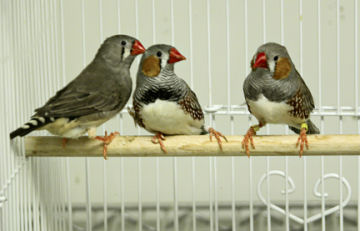Female zebra finches, normally devoted to their mates, are more likely to flirt with male strangers when background noise goes up, say researchers.

A test with finches in a lab found that white noise with the loudness of heavy traffic virtually wipes out female loyalty to established mates, says John P. Swaddle of the College of William and Mary in Williamsburg, Va. Yet those same females strongly prefer their mates when tested in a hushed room.
“This is a new way of thinking about the consequences of noise pollution,” says Swaddle.
Previous research had raised concerns that noise pollution can stress animals, and some studies found that birds change their songs’ frequencies (SN: 7/19/03, p. 37) or timing, as if trying to make themselves heard above the urban cacophony. Direct evidence that human-generated noise can change important things like the number of young fledged “is still lacking,” cautions Hans Slabbekoorn of Leiden University in the Netherlands. He says that he’s planning research into that question.
Swaddle says that he was investigating another finch habit when he noticed female zebra finches losing interest in video images of their mates. He wondered whether the anomaly had something to do with the white noise coming from the video monitor.
To test noise effects, he and William and Mary undergraduate Laura Page worked with 20 pairs of zebra finches that had each spent at least 4 months as a couple. Researchers put each female in a private cage and offered her two males that she could flirt with through the bars. One was her mate, and the other was a stranger.
The researchers observed each combination of birds during test sessions with different background noises. For the quietest test, the researchers let the building’s air conditioner hum. It provided about 45 decibels of sound at the birdcage. For the loudest, they played a white noise CD that blared 90 dB of sound at the birds. Bursts of city noises or the racket in lab aviaries can exceed that level, says Swaddle, as can certain natural sounds, such as cicada choruses, in the birds’ home range.
The lab noise didn’t seem to upset the established pairs greatly, since they courted with enthusiasm, Swaddle says. When up against loud noises, however, a female was as likely to prefer a stranger as her mate, he and Page report in the September Animal Behaviour.
Swaddle says he needs to do more testing to figure out why this happens. He notes that males perform more of their stylized courtship hops when around unfamiliar females than around their mates. If noise jams vocal communication, the extra display might win attention, Swaddle speculates.
Regardless of why they happen, increasing extrapair matings could alter a population’s evolutionary trajectory, he says.
Extrapair encounters intensify the pressures of sexual selection, which favors enhancement of sexy traits. That enhancement can sap resources normally devoted to other activities.
“Many of the effects [of noisy environments] may initially seem subtle,” says Richard Fuller of the University of Sheffield in England. Still, they “could have profound genetic and evolutionary consequences.”






